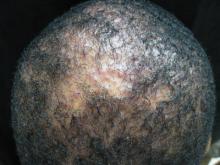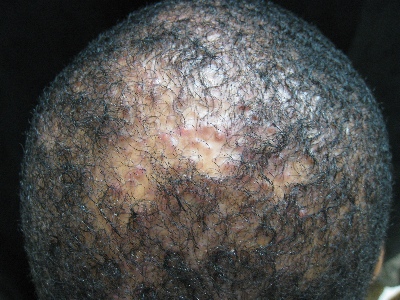User login
The patient was given a diagnosis of folliculitis decalvans (FD), a highly inflammatory form of scarring alopecia characterized by inflammatory perifollicular papules and pustules. The term scarring alopecia refers to the fact that the follicular epithelium has been replaced by connective tissue, ultimately resulting in permanent hair loss. Affected areas commonly include the vertex and occipital scalp. Common symptoms include pain, itching, burning, and occasionally spontaneous bleeding or discharge of purulent material.
FD generally occurs in young and middle-aged African Americans with a slight predominance in males, but can occur in any ethnic group at any age. The etiology is not fully understood; however, scalp colonization with Staphylococcus aureus has been implicated as a contributing factor. Some reports suggest that patients may have an altered host immune response and/or genetic predisposition for the condition.
Two scalp biopsies should be performed to make the diagnosis. One biopsy should be processed for standard horizontal sectioning, but the second biopsy should be bisected vertically, with half sent for histologic examination and the other half for tissue culture (fungal and bacterial).
Primary treatment is aimed at eliminating S aureus colonization, often with oral antibiotic therapy. Adjunctive topical and intralesional corticosteroids may help reduce inflammation and provide relief from itching, burning, and pain.
In this case, the patient was prescribed oral doxycycline 100 mg twice daily, as well as clobetasol 0.05% topical solution, to be applied to the affected area in the morning and evening. The patient’s symptoms improved within 2 months. The plan was to wean him off doxycycline over a 6-month period and then transition him to topical clindamycin solution twice daily.
Adapted from: Moss TA, Beachkofsky TM, Almquist SF, et al. Alopecia with perifollicular papules and pustules. J Fam Pract. 2011;60:95-98.
The patient was given a diagnosis of folliculitis decalvans (FD), a highly inflammatory form of scarring alopecia characterized by inflammatory perifollicular papules and pustules. The term scarring alopecia refers to the fact that the follicular epithelium has been replaced by connective tissue, ultimately resulting in permanent hair loss. Affected areas commonly include the vertex and occipital scalp. Common symptoms include pain, itching, burning, and occasionally spontaneous bleeding or discharge of purulent material.
FD generally occurs in young and middle-aged African Americans with a slight predominance in males, but can occur in any ethnic group at any age. The etiology is not fully understood; however, scalp colonization with Staphylococcus aureus has been implicated as a contributing factor. Some reports suggest that patients may have an altered host immune response and/or genetic predisposition for the condition.
Two scalp biopsies should be performed to make the diagnosis. One biopsy should be processed for standard horizontal sectioning, but the second biopsy should be bisected vertically, with half sent for histologic examination and the other half for tissue culture (fungal and bacterial).
Primary treatment is aimed at eliminating S aureus colonization, often with oral antibiotic therapy. Adjunctive topical and intralesional corticosteroids may help reduce inflammation and provide relief from itching, burning, and pain.
In this case, the patient was prescribed oral doxycycline 100 mg twice daily, as well as clobetasol 0.05% topical solution, to be applied to the affected area in the morning and evening. The patient’s symptoms improved within 2 months. The plan was to wean him off doxycycline over a 6-month period and then transition him to topical clindamycin solution twice daily.
Adapted from: Moss TA, Beachkofsky TM, Almquist SF, et al. Alopecia with perifollicular papules and pustules. J Fam Pract. 2011;60:95-98.
The patient was given a diagnosis of folliculitis decalvans (FD), a highly inflammatory form of scarring alopecia characterized by inflammatory perifollicular papules and pustules. The term scarring alopecia refers to the fact that the follicular epithelium has been replaced by connective tissue, ultimately resulting in permanent hair loss. Affected areas commonly include the vertex and occipital scalp. Common symptoms include pain, itching, burning, and occasionally spontaneous bleeding or discharge of purulent material.
FD generally occurs in young and middle-aged African Americans with a slight predominance in males, but can occur in any ethnic group at any age. The etiology is not fully understood; however, scalp colonization with Staphylococcus aureus has been implicated as a contributing factor. Some reports suggest that patients may have an altered host immune response and/or genetic predisposition for the condition.
Two scalp biopsies should be performed to make the diagnosis. One biopsy should be processed for standard horizontal sectioning, but the second biopsy should be bisected vertically, with half sent for histologic examination and the other half for tissue culture (fungal and bacterial).
Primary treatment is aimed at eliminating S aureus colonization, often with oral antibiotic therapy. Adjunctive topical and intralesional corticosteroids may help reduce inflammation and provide relief from itching, burning, and pain.
In this case, the patient was prescribed oral doxycycline 100 mg twice daily, as well as clobetasol 0.05% topical solution, to be applied to the affected area in the morning and evening. The patient’s symptoms improved within 2 months. The plan was to wean him off doxycycline over a 6-month period and then transition him to topical clindamycin solution twice daily.
Adapted from: Moss TA, Beachkofsky TM, Almquist SF, et al. Alopecia with perifollicular papules and pustules. J Fam Pract. 2011;60:95-98.

